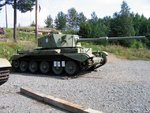davebender
1st Lieutenant
I agree. In fact Israel got good service from Sherman tanks as late as 1973.
Israel captured quite a few T-55s. I suspect they performed just fine with well trained crews.
BTW, I wouldn't bet on Soviet tank crews being well trained during Cold War. Better trained then Arab armies but that isn't saying much.
Israel captured quite a few T-55s. I suspect they performed just fine with well trained crews.
BTW, I wouldn't bet on Soviet tank crews being well trained during Cold War. Better trained then Arab armies but that isn't saying much.

 ](*,)](/forum/images/smilies/eusa_wall.gif)

